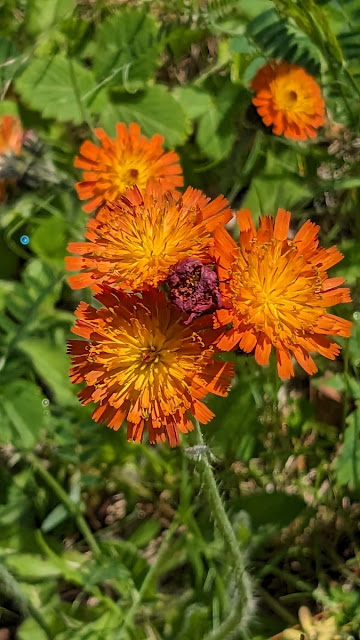A few weeks ago I mentioned that dragonflies and damselflies have some interesting mating techniques, and with lots of these mythical creatures now emerging from the depths, July is a good time to observe them in action.
 |
| A male (blue) and female (tan) bluet damselfly in their mating configuration. |
As I mentioned previously (May 28, 2023) dragonflies and damselflies are considered aquatic animals because they spend most of their lives as nymphs living in the water. After a number of months - or even years - they emerge from the water and transform into the flying creatures we usually see. They climb up out of the lake on plants and docks where they extricate themselves from their final aquatic shell as almost-flying creatures.
 |
| A newly hatched damselfly next to a shed larva shell. |
Before they can fly they need to bake in the sun while they pump up and dry out their wings. You may find their old exoskeletons left behind with a small hole in the top where they climbed out,
Here I could see the hole through which it escaped its juvenile prison. It's rather amazing that the adult was packed into that small skin, let alone being able slide out its fragile legs.
Out in a marsh, this next dragonfly climbed up a reed, escaped from its skin, then climbed up another inch to dry itself in the sun, hoping it could become airborne before it was gobbled up by a predator:
 |
| A freshly metamorphosed dragonfly and its exoskelteon. |
After emerging, the adult dragonfly's (and damselfly's) primary mission is to find a mate and reproduce. This is where it gets really interesting. The male and female dragonfly have their reproductive organs on opposite ends of their body which results in a heart-shaped mating position, with the female holding onto the male while it deposits sperm from near its thorax into the female's receptacle near its tail.
 |
| The male is blue, the female green. |
The process takes a few minutes so you often see Odonata (the order that includes dragonflies and damselflies) flying in their mating position. As in many species, the female is the one that selects a mate. Males will demonstrate their acrobatic abilities, and the female will select one of her choosing. After mating, the female will do its best to avoid any other interested males, going so far as to fall to the ground and play dead in some species when approached by another male. The reason for this is that male dragonflies have the ability to remove any existing sperm in a female before depositing its own. This would mean the female's chosen mate's genes would be eliminated from her offspring.
After mating, the female will place the fertilized eggs either on a plant or directly into the water. Perhaps you've seen a dragonfly in a touch-and-go flight pattern, dropping down to touch the surface of the lake and then taking off again. Each time it touches the water it is depositing one egg in the lake from the end of its body. Thus a new cycle begins, as the egg will hatch into a new dragonfly larva, consuming microscopic organisms as it grows though multiple molts as a larva. Different species of Odanata (there are over 7000 species) have differences in their anatomy and behavior, but most of them have similar traits.
Lakes, streams, wetlands - they truly are the fountain of life. This week I was up in the mountains, hiking on Mt. Cardigan and Firescrew. There on the open ledges of Firescrew is a small alpine lake.
 |
| An alpine lake on the Firescrew ledges. |
As we approached the lake my hiking partner heard something familiar, and we had to stop and listen to believe what what were hearing. There was no doubt; here, in the alpine zone, at an elevation over 3000 feet, was a frog. We didn't leave the trail in this fragile habitat to look for it, but it sounded like a green frog.
 |
| I've always seen green frogs near the lakes, where this one was hunting for insects. |
I never expected to find a frog in this adverse environment. Then, my hiking companion posed the astute question "how did it get here?" There are streams nearby, but none that flowed out of this isolated pond in a depression in the granite. I suppose frogs migrate up streams, and in a dry summer, when a stream dries up, they may go in search of the water a frog needs to survive.
There's always some new wonder to discover in nature.
We also saw quite a few pretty alpine flowers on the hike, including three-toothed cinquefoil:
 |
| Three-toothed cinquefoil on the high Firescrew ledges. |
By the way, Firescrew supposedly got its name from the smoke of a wildfire on the mountain that was twisted up into the sky by swirling winds into a large vertical corkscrew shape.
On our hike, it was smoke from wildfires in Canada that made for the hazy sky, but it was a great hike with my sister - thanks for the adventure!
 |
| The summit of Mt. Cardigan from Firescrew. |
Back at Lake Wicwas all is well with the loons. LuLu and Checkers have been protected from all threats and are doing well, and the second pair is still tending to their eggs on the nest in Harris Cove. They should be hatching about one week from now.
I hope you have a great Fourth of July, enjoying some fireworks, whether man-made or nature-made!
 |
| Orange hawkweed, Nature's fireworks. |
Happy Fourth of July!

Scott! Thanks for another week…learning about nature…so much to learn and to be thankful. Happy Fourth…T
ReplyDeleteAlways so interesting and fun! Thanks, Scott!
ReplyDelete